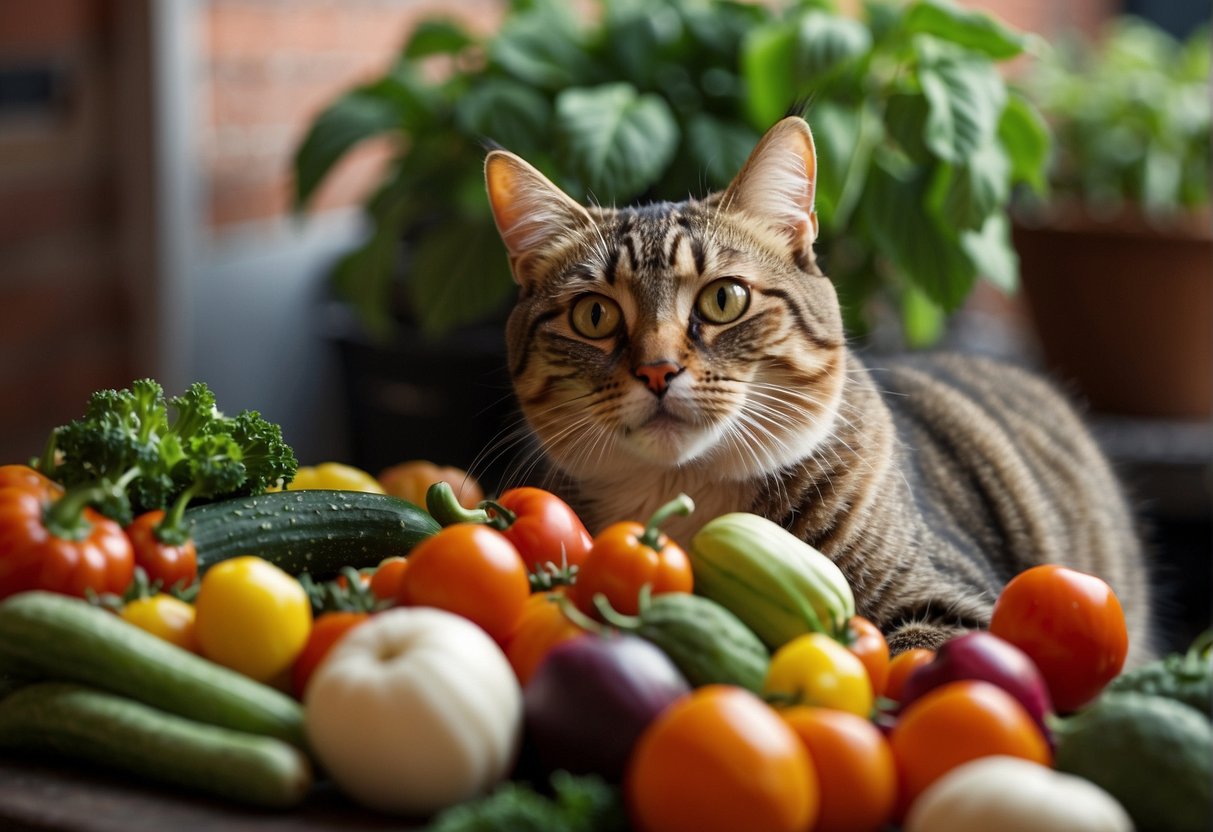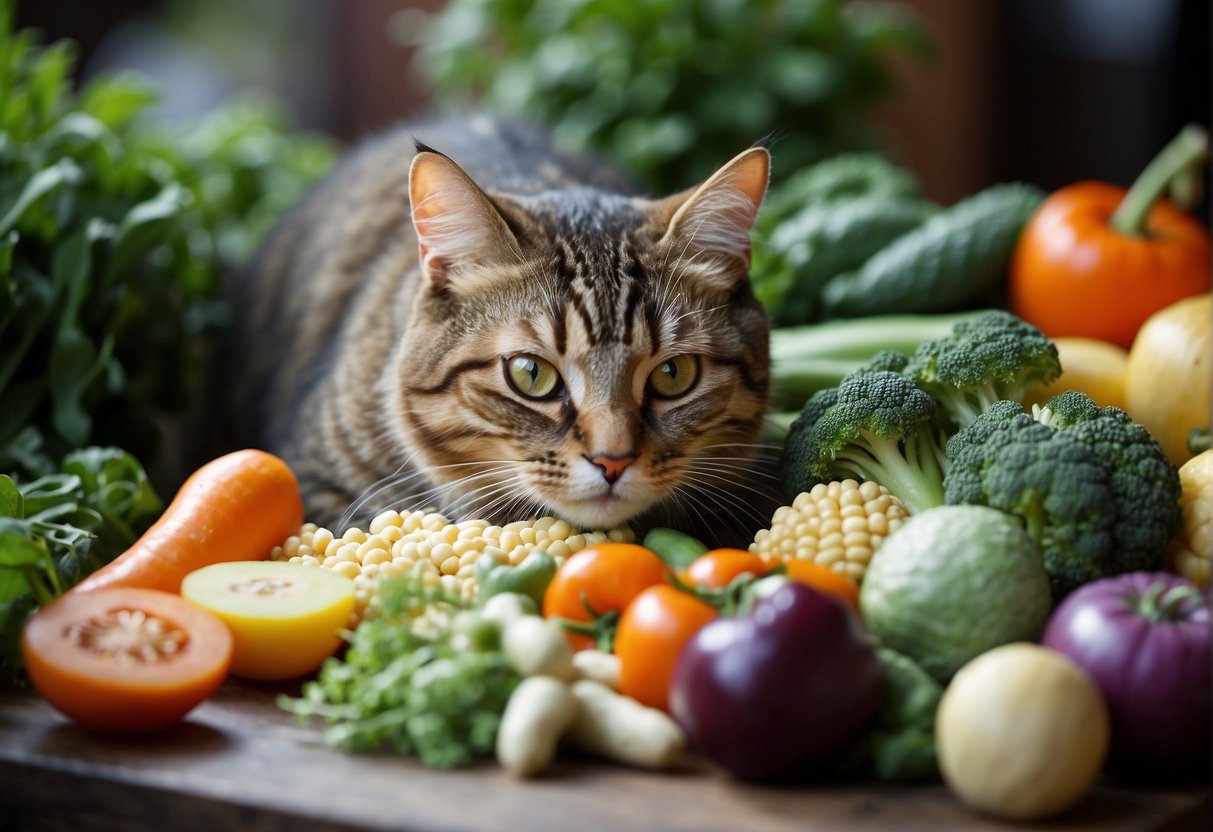Cats certainly can eat vegetables, and including them in their diet can offer a boost of nutrients.
When you introduced fresh veggies to your feline friend’s mealtime, perhaps they sniffed curiously at those green beans or took a tentative nibble on a piece of steamed carrot. These small additions can be a source of vitamins and are often a low-calorie treat.
My own experiences have shown that while some cats might turn up their noses, others may surprise you with their willingness to try these healthy snacks.

However, remember that cats are obligate carnivores, meaning their primary nutritional needs are met through protein from meat. While vegetables can complement their diet, they should not replace meat as the main component.
I’ve always made sure any veggies I serve are prepared safely—cooked and unseasoned is the rule—since some raw vegetables can be difficult for cats to digest.
Incorporating vegetables into your cat’s diet should be approached with caution. Veggies like carrots and peas can make for a safe treat in moderation, but it’s essential to avoid anything potentially toxic like onions or garlic.
Nutritional Benefits of Vegetables for Cats

While cats mainly need a protein-rich diet, certain vegetables can offer supplementary nutrition. Let’s explore how they can benefit your feline friend.
Vitamins and Minerals in Vegetables
Vegetables are a rich source of vitamins and minerals that can be beneficial to your cat’s health. They can provide vitamins such as vitamin A and vitamin C, along with minerals like potassium and magnesium.
However, it’s essential to ensure these are given in proper amounts, as cats have unique nutritional requirements.
- Carrots: Provide beta-carotene, which converts to vitamin A
- Broccoli & Green beans: Good sources of antioxidants and vitamin C
Fiber Content and Digestive Health
Fiber found in vegetables can aid in your cat’s digestive health, regulating bowel movements and helping to prevent issues like constipation or diarrhea. While cats do not require a lot of fiber, a moderate amount can be beneficial.
- Pumpkin & Sweet potato: Excellent sources of fiber that can improve gut health
Weight Management and Caloric Content
Incorporating vegetables into your feline’s diet can be a strategic way to manage calorie intake. They are low in calories but high in volume, which can help overweight cats feel fuller without adding excessive weight.
Potential Risks and Toxicities
Be cautious of certain vegetables and plants from the allium family, such as onions, garlic, chives, and leek, which are toxic to cats. Additionally, oxalate-containing vegetables like spinach may contribute to calcium oxalate bladder stones.
- Avoid: Onions, garlic, and anything in the allium family due to their poisonous nature
Safe Vegetables and Serving Ideas
Some vegetables are safe for cats when prepared properly. Always serve them cooked to aid in digestion and only offer small, bite-sized pieces as a treat, not a meal replacement.
- Safe veggies: Cooked carrots, steamed broccoli, and mashed pumpkin
- Serving idea: Mix a small amount of steamed vegetables with their regular food
Incorporating Vegetables into a Cat’s Diet
When introducing vegetables to your cat’s diet, it’s essential to do so gradually to avoid digestive issues. Always ensure a proper balance between meat and vegetables, and pay close attention to the frequency and quantity to promote your feline friend’s health and well-being.
How to Introduce Vegetables
To begin integrating vegetables into your cat’s meals, start with small, cooked pieces of cat-safe veggies like pumpkin, carrots, or peas. You can mix these into their regular food to help them get accustomed to the new flavors and textures.
Watch for any signs of digestive upset, such as diarrhea or vomiting, as these could indicate that your cat is not tolerating the new addition well.
Balancing Meat and Vegetable Intake
Cats are obligate carnivores, which means their diet should be primarily composed of meat. However, adding a bit of vegetable matter can contribute to their bowel movements and overall digestive health.
Always remember that vegetables should only play a supportive role and never replace animal protein in your cat’s diet. Aim to keep veggies less than 10% of their total food intake.
Frequency and Quantity of Vegetables
Your feline’s vegetable intake should be moderate. This is to prevent digestive issues like constipation or diarrhea. It’s advisable to offer vegetables as a treat or part of a meal no more than a few times a week.
Always chop vegetables into bite-sized pieces to prevent choking and make them easier to digest. Begin with a teaspoon-size amount per meal and observe your cat’s reaction before offering more.

My name is James, and welcome to FAQCats!
Along with our team of cat owners, expert pet enthusiasts, and pet professionals, we aim to write engaging helpful, engaging content about cats. At FAQCats we strive to provide content that’s accurate and fun to read. Our team writes about everything related to cats; even the most complex of topics. Through extensive research and caring for our own fur-pals, we’re able to provide something cat owners worldwide will love. Have a look around, and leave us feedback anytime!

